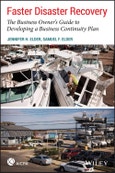Protect your company’s finances in the event of a disaster
In the face of an environmental or man-made disaster, it’s imperative to have a contingency plan that’s mapped out your corporation’s strategy to minimize the impact on the daily functions or life of the corporation. Successful planning not only can limit the damage of an unforeseen disaster but also can minimize daily mishaps - such as the mistaken deletion of files - and increase a business's overall efficiency.
Faster Disaster Recovery provides a 10-step approach for business owners on creating a disaster recovery plan (from both natural and man-made events). Each chapter ends with thought-provoking questions that allow business owners to explore their particular situation.
- Covers natural events such as earthquakes and floods
- Provides guidance on dealing with man-made events such as terrorist attacks
- Offers worksheets to make your contingency plans
- Includes several examples throughout the book
There’s no time like the present to develop a business contingency plan - and this book shows you how.
Table of Contents
Preface xi
Chapter 1 Business Disaster Defined 1
Disaster Timing and Size 2
Disaster Types 3
Note 4
Chapter 2 Why You Need a Plan 5
Disasters Occur . . . a Lot 6
Disasters Happen Quickly 9
Disaster Response Is Expensive 11
Impaired Response 13
Some Industries Require Them 13
Your Reputation and Value Are at Stake 14
Additional Reasons 14
Why Businesses Fail to Plan 15
Notes 17
Chapter 3 Business Continuity Planning 19
The Five-Step Business Continuity Cycle 21
The Business Continuity Planning Process 23
Getting Started 24
Note 25
Chapter 4 Step 1: Obtain Management Support 27
Management’s Role 28
Obtaining Management Support and Approval 29
Note 32
Chapter 5 Step 2: Assemble a Planning Team 33
Role of the Planning Team 34
Who to Include 35
Organization of the Team 35
The First Meeting 37
Chapter 6 Step 3: Collect Data 39
Identify Your Mission-Critical Functions 40
Department Evaluations 41
Policies and Procedures 41
Regulatory Codes and Requirements 43
Useful Documents 43
Sample Forms 48
Chapter 7 Step 4: Evaluate Operations 49
Chapter 8 Step 5: Identify and Evaluate Risks 53
Risk Assessment Process 54
Three Risk Assessment Methods to Consider 66
Assign a Chief Risk Officer 72
Chapter 9 Step 6: Determine Recovery Strategies 75
Prevention 76
Incident Response 78
Business Continuation 81
Communications During a Disaster 82
Chapter 10 Steps 7–10: Create, Communicate, Test, and Regularly Update Your Written Plan 89
A Complete Business Continuity Plan 90
A Basic Business Continuity Plan 93
After the Plan is Written 94
Practice Your Plan 96
Chapter 11 Insurance Coverage 99
Predisaster Financial Planning 100
Basic Types of Insurance 102
Understanding Your Coverage 106
Concepts to Know 107
Filing an Insurance Claim 111
Insurance Adjuster versus Public Adjuster 113
Notes 116
Chapter 12 Computer Systems: Disaster Prevention and Recovery 117
Causes and Costs of IT Disasters 121
IT Disaster Prevention 123
Laptop and Cell Phone Protection 126
Network Security 129
Operating in the “Cloud” 130
Creating an IT Disaster Recovery Plan 132
Cyber Insurance 136
Notes 137
Chapter 13 Special Disaster Issues 139
Power Outage 140
Fire 141
Hazardous Materials Spill 142
Flood 143
Hurricane 145
Earthquake 146
Tornado 147
Winter Storm 148
Heat Wave 149
Flu 150
Conclusion 151
Appendix A Insurance Coverage Worksheet 153
Appendix B Risk Analysis Worksheet 155
Appendix C Damage Assessment Form 159
Appendix D Summary of Communication Systems 161
Appendix E Emergency Communications Summary 163
Appendix F Business Continuity Plan Outline 165
Appendix G Schedule of Training and Testing 169
Appendix H List of U.S. Privacy Laws 171
Appendix I IT Backup and Testing Log 175
Appendix J Sample Computer Network Map 177
About the Author 179
Index 181








